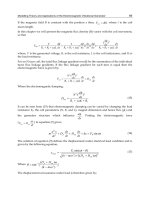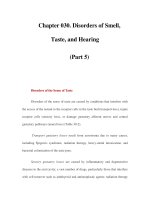Chapter 030. Disorders of Smell, Taste, and Hearing (Part 5) pptx
Bạn đang xem bản rút gọn của tài liệu. Xem và tải ngay bản đầy đủ của tài liệu tại đây (12.22 KB, 5 trang )
Chapter 030. Disorders of Smell,
Taste, and Hearing
(Part 5)
Disorders of the Sense of Taste
Disorders of the sense of taste are caused by conditions that interfere with
the access of the tastant to the receptor cells in the taste bud (transport loss), injure
receptor cells (sensory loss), or damage gustatory afferent nerves and central
gustatory pathways (neural loss) (Table 30-2).
Transport gustatory losses result from xerostomia due to many causes,
including Sjögren's syndrome, radiation therapy, heavy-metal intoxication, and
bacterial colonization of the taste pore.
Sensory gustatory losses are caused by inflammatory and degenerative
diseases in the oral cavity; a vast number of drugs, particularly those that interfere
with cell turnover such as antithyroid and antineoplastic agents; radiation therapy
to the oral cavity and pharynx; viral infections; endocrine disorders; neoplasms;
and aging.
Neural gustatory losses occur with neoplasms, trauma, and surgical
procedures in which the gustatory afferents are injured. Taste buds degenerate
when their gustatory afferents are transected but remain when their somatosensory
afferents are severed. Patients with renal disease have increased thresholds for
sweet and sour tastes, which resolves with dialysis.
Table 30-2 Causes of Gustatory Dysfunction
Transport Gustatory Losses
Drugs
Heavy-metal intoxication
Radiation therapy
Sjögren's syndrome
Neural Gustatory Losses
Diabetes mellitus
Hypothyroidism
Oral neoplasms
Oral surgery
Xerostomia
Sensory Gustatory Losses
Aging
Candidiasis
Drugs (antithyroid and antineoplastic)
Endocrine disorders
Oral neoplasms
Pemphigus
Radiation therapy
Viral infections (especially with
herpes viruses)
Radiation therapy
Renal disease
Stroke and other CNS
disorders
Trauma
Upper respiratory tract
infections
A side effect of medication is the single most common cause of taste
dysfunction in clinical practice. Xerostomia, regardless of the etiology, can be
associated with taste dysfunction.
It is associated with poor oral clearance and poor dental hygiene and can
adversely affect the oral mucosa, all leading to dysgeusia. However, severe
salivary gland failure does not necessarily lead to taste complaints.
Xerostomia, the use of antibiotics or glucocorticoids, or immunodeficiency
can lead to overgrowth of Candida; overgrowth alone, without thrush or overt
signs of infection, can be associated with bad taste or hypogeusia. When taste
dysfunction occurs in a patient at risk for fungal overgrowth, a trial of nystatin or
other antifungal medication is warranted.
Upper respiratory infections and head trauma can lead to both smell and
taste dysfunction; taste is more likely to improve than smell. The mechanism of
taste disturbance in these situations is not well understood.
Trauma to the chorda tympani branch of the facial nerve during middle ear
surgery or third molar extractions is relatively common and can cause dysgeusia.
Bilateral chorda tympani injuries are usually associated with hypogeusia, whereas
unilateral lesions produce only limited symptoms.
As noted above, aging itself may be associated with reduced taste
sensitivity. The taste dysfunction may be limited to a single compound and may be
mild.









